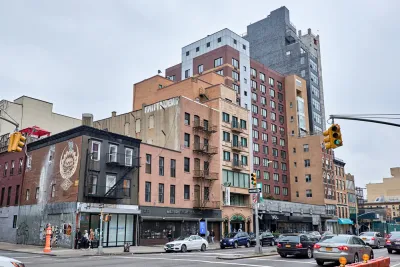Many cities require the owners of multistory buildings to regularly inspect their façades, looking for problems that may lead to injury or property damage. Drones can potentially help ease the process and cost of doing so.

Why is this important? What are the potential implications for the built environment?
Many cities require the owners of multistory buildings to regularly inspect their façades, looking for problems that may lead to injury or property damage — loose masonry at risk of crashing to the sidewalk below, for instance.
These investigations are typically conducted in two stages. In the first, inspectors located on the ground or in adjacent buildings use binoculars to conduct a visual inspection. In the second, they study the façade up close, performing physical tests as needed.
The second stage often requires costly and disruptive interventions to the building and the surrounding neighborhood. Since many buildings lack the equipment needed to safely lower inspectors down the façade, owners frequently erect scaffolding that can block signage, views, and pedestrian pathways — sometimes for weeks on end, depending on the building’s size.
Finding a way to improve the first stage of the inspection in order to shorten the duration of the second could make these studies much cheaper and less invasive. It could also improve inspector safety, reducing the need for climbing around scaffolding or rappeling down the side of buildings.
FULL STORY: Can drones inspect urban building facades?

National Parks Layoffs Will Cause Communities to Lose Billions
Thousands of essential park workers were laid off this week, just before the busy spring break season.

Retro-silient?: America’s First “Eco-burb,” The Woodlands Turns 50
A master-planned community north of Houston offers lessons on green infrastructure and resilient design, but falls short of its founder’s lofty affordability and walkability goals.

Delivering for America Plan Will Downgrade Mail Service in at Least 49.5 Percent of Zip Codes
Republican and Democrat lawmakers criticize the plan for its disproportionate negative impact on rural communities.

Test News Post 1
This is a summary

Test News Headline 46
Test for the image on the front page.

Balancing Bombs and Butterflies: How the National Guard Protects a Rare Species
The National Guard at Fort Indiantown Gap uses GIS technology and land management strategies to balance military training with conservation efforts, ensuring the survival of the rare eastern regal fritillary butterfly.
Urban Design for Planners 1: Software Tools
This six-course series explores essential urban design concepts using open source software and equips planners with the tools they need to participate fully in the urban design process.
Planning for Universal Design
Learn the tools for implementing Universal Design in planning regulations.
EMC Planning Group, Inc.
Planetizen
Planetizen
Mpact (formerly Rail~Volution)
Great Falls Development Authority, Inc.
HUDs Office of Policy Development and Research
NYU Wagner Graduate School of Public Service


























